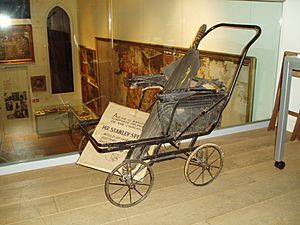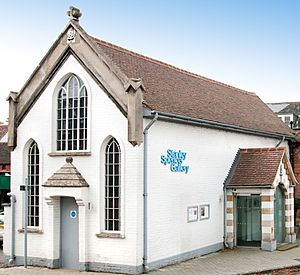Stanley Spencer Gallery facts for kids
The Stanley Spencer Gallery is a special art museum in the South of England. It celebrates the life and amazing artwork of Stanley Spencer. This gallery opened in 1962. You can find it in the village of Cookham, Berkshire, right by the River Thames. Stanley Spencer was born here and lived most of his life in Cookham. The gallery has more than 100 paintings and drawings. Some of these are on long-term loan. The gallery often puts on new shows. These shows sometimes include art borrowed from other museums.
Contents
The Gallery's Story
Cookham was super important to Stanley Spencer. He even called it 'a Village in Heaven'. This village gave him endless ideas for his art throughout his life. After he passed away in 1959, his friends wanted to create a special place. They wanted a permanent home in Cookham to show his paintings and drawings. This would be a way to remember him.
Many people helped with this project. These included Joan George, Gerard Shiel, Donald Rademacher, and Rev Michael Westropp. In 1962, the Gallery opened inside the old Wesleyan Chapel. Stanley Spencer used to go to this chapel with his mother when he was a child. Lord Astor, who supported Spencer, wrote about the gallery when it opened:
This Gallery is in its nature modest. It can only show a selection of Stanley Spencer’s pictures though they will vary each year. But perhaps a great edifice would be less typical of Stanley than this Gallery which is in scale with the rest of the village and reflects the nature of Stanley; small, cheerful, very special and deeply loved.
Many artworks were borrowed for the first show. Some of these are now part of the gallery's main collection. This includes a huge painting called Christ Preaching at Cookham Regatta. Spencer had not finished it when he died. Spencer's daughters, Shirin and Unity, came to the opening. They have supported the Gallery a lot over the years. The Gallery was first run by a paid person. But now, a team of volunteers runs it very well.
The Gallery Building
The Wesleyan chapel on Cookham High Street was built in 1846. It was a simple building made of brick and slate. It could hold up to 107 people. Stanley Spencer went to this chapel with his mother. Her brother had been a local preacher there.
The church services made a big impact on the young artist. He felt a strong spiritual connection to the small building. More than thirty years later, he could still remember it in great detail. He used these memories to draw Ecstasy in a Wesleyan Chapel. This drawing is now in the Gallery's collection.
The chapel was used less after a bigger Methodist Church was built. This new church was in nearby Cookham Rise in 1904. The old chapel eventually closed. The Spencer family was very upset about this. They tried hard to keep it open. Stanley's brother, Gilbert Spencer, remembered:
On 17 April 1910 Stan and I saw the key turned in the door of Cookham Chapel for the last time after the evening service. And with this, I think an important and significant influence in my brother's life came to an end.
After that, a local helper named Colonel Ricardo changed the building. He turned it into the "King's Hall". This was a reading and recreation room for people in the village. It stayed like this until the Second World War. After the war, it was used for different things. One activity was a life drawing class suggested by Stanley Spencer.
After Spencer died in 1959, a young artist named Faith Gibbon was using the old chapel as her studio. She had become friends with Spencer. She invited the group planning the new gallery to visit her. That's when they decided the chapel was the perfect place for The Stanley Spencer Gallery. They made some simple changes. They blocked up the side windows to have more space for hanging art. They also put in a new floor, doors, and lights.
In 2006 and 2007, the building was completely updated. This cost over £800,000. It was possible thanks to the Heritage Lottery Fund. The gallery reopened on September 29, 2007. It became a modern, bright space. This new design helps Spencer's artworks look their best. A new upper floor was added. New, modern equipment was put in. This careful update brought back the simple beauty of the building that Stanley Spencer loved so much.
Spencer's Cookham Village
Spencer was born at Fernlea on Cookham High Street on June 30, 1891. He was the tenth of 11 children in his family. His grandfather, Julius, who was a Master Builder, built the house. Julius also built the local school and many other houses in the village.
Before the First World War, Cookham was a quiet country village. It was a bit cut off from the outside world. The curve of the River Thames made it feel almost like an island. The village high street had a blacksmith, a baker, a butcher, a chemist, and a working farm. All these places would later appear in his artwork.
Young Spencer was fascinated by everything around him. He loved seeing the cows in the barn across from his bedroom. He also found interest in the piles of rubbish in the farmyard. (This was before regular trash collection in the village). He often swam in the river. He said his early morning swim, when sunlight hit the water, 'was the time for visitations'.
His early education was simple. His two sisters taught him in a small shed in his grandmother's garden. This helped him love nature. Long walks through the woods and meadows were a regular part of his life. He often returned to the sights of his childhood village in his art. For example, his 1958 painting Crucifixion was inspired by piles of rubble on the High Street. This rubble was from when they were laying new drainage pipes.
Cookham has changed a lot since Spencer's early days. But you can still see many places from his paintings. You can even see the views he drew so well. Some of the village feeling he enjoyed can be found by walking through the Holy Trinity churchyard. You can also follow Spencer's path along the river bank up to Cockmarsh and Winter Hill.
The Art Collection
The Stanley Spencer Gallery has one of the largest collections of Stanley Spencer's art in the world. It includes 24 paintings, 66 drawings, 8 prints, and 3 very early works in pen and ink.
A very important part of the collection came in 1995. This was the Barbara Karmel gift. It included four oil paintings. One of these is a masterpiece called Sarah Tubb and the Heavenly Visitors (1933). It also included eight drawings, some of his earliest ones. You can see the full collection online on the Gallery's website.
The collection shows all kinds of Spencer's work. This includes early sketches and studies, as well as finished paintings. For example:
- Woolshop (The) Drawing, pencil on paper – 16in x 11in
- Sarah Tubb and the Heavenly Visitors (Study) (1933) Drawing, pencil on squared paper, 9in x 8in
Paintings
- Sarah Tubb and the Heavenly Visitors (1933) Painting, oil on canvas – 36in x 40in
- Christ Preaching at Cookham Regatta (1952–59) Painting, oil on canvas unfinished – 81in x 211in
Portraits
- Self Portrait (1923) Painting, oil on canvas – 20in x 16in
- Portrait of Mr and Mrs Baggett (1956) Painting, oil on canvas – 24in x 36in
Gardens and Landscapes
- Englefield House, Cookham (1951) Painting, oil on canvas – 30in x 20in
- Neighbours (1936) Painting, oil on canvas – 30in x 20in
The Gallery Archive

On the upper floor of the gallery, there is a small study area. This area holds books and old documents. It also has a computer presentation about the artist and his work. You can look at many books and articles about Stanley Spencer there. These are available during opening hours.
Some of the old documents you can easily see include:
- Files of newspaper clippings (from the 1920s until now).
- Student papers and essays.
- Written memories from people who knew Spencer.
- Exhibition catalogs.
- Copies of letters written by Stanley Spencer. This includes letters he wrote during the First World War to his friend, the artist and poet Desmond Chute. The original letters are kept in the Gallery's archive.
You can also see more archive materials by making an appointment. These include sound recordings of people who knew Spencer. There are also research papers from Spencer's biographer, Kenneth Pople. Plus, there is a large collection of photographs.
Some items that belonged to Stanley Spencer are always on display in the Gallery. One interesting item is the pram he famously used. He used it to carry his painting supplies around the village. Also on display are the tiny brushes he used for the fine details in his later artworks.
Past Exhibitions
The exhibitions at the gallery change every six months. The summer show usually includes borrowed artworks based on a certain topic. The winter show usually features art from the Gallery's own collection.
Since the gallery started, many different parts of Spencer's art have been shown. These include portraits, landscapes, and his visionary works. They also show places both far and near, and specific times in the artist's life. Art by his family and other artists from his time have also been shown. (You can find catalogs of all past exhibitions on the library shelves in the gallery).
A special exhibition in recent years was The Art of Shipbuilding on the Clyde in 2011. During this show, the whole gallery was filled with large paintings. Spencer made these during the Second World War. He was sent to Lithgows Shipyard in Port Glasgow as an official World War II artist.
Other exhibitions have included Stanley Spencer in Cookham (from November 7, 2013, to March 30, 2014). Another was Paradise Regained. Spencer in the Aftermath of the First World War (from April 2 to November 2, 2014). This show was timed with the 100-year anniversary of the First World War. It looked at how this huge event affected Stanley Spencer's art. Key paintings from that time were on display. Through these, the artist tried to get back the artistic vision he feared he had lost because of the war. The show also had artworks and extra materials about Spencer's war experiences in Macedonia. It also showed how he planned the Burghclere Chapel. The Summer Exhibition for 2025 is ‘That Marvelous Atmosphere’ (Stanley Spencer and Cookham Regatta).
Images for kids
See also
- List of single-artist museums





